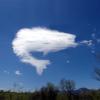Fish High or Low?
Not a stupid question at all. But, there really aren't pat answers. I'll try to offer some generalities, as I understand them, that hopefully will help you make decisions when fishing.
Bass relate to structure/cover so they are usually somewhat close to one or the other. In general, actively hunting bass are above bottom. Unless they are keying on crayfish, bass tend to be piscivorous and are oriented to food above them. People catch bass on bottom often because bass, being mostly shallow water fish (usually <15ft in most waters), prefer to stay below the level in which they can be seen from the surface, which puts them relatively close to the bottom. Slow bottom presentations can be very attractive to bass, and trigger strikes as they drag or bang bottom. This doesn't necessarily mean the bass were "on bottom".
In general, resting bass (called neutral/negative) tend to be on bottom, usually near or in cover. These fish are often catchable if you can find and get to them. Some bottom caught bass are these guys. (Of course, ithere are always exceptions -In some waters, (usually deep, clear, heavily fished waters) bass may suspend away from bottom when resting.
Bass almost always relate to cover objects, and more than one diver has described bass as "acting as though the top of the cover (especially weeds and wood) is the "bottom". Not the actual bottom!
Understand and make use of "ambush points". "Ambush points" are something physical that obscures the falsity of the lure, makes the lure look as though it might escape, and/or offers a corral to contain the lure (making it appear catchable). Presentations up in the water column, in open water, are often more difficult to trigger strikes in. Easier to get follows, but without something to bang off of, hide behind, and appear to "corral/contain" the prey, it's tougher to trigger fish. Bass know when something is vulnerable -in fact that's what they are looking for when hunting. This is why topwaters can be so effective, if you can get them to come all the way to the surface (conditions dependent) -the surface film is a great "ambush point"-something that obscures the falseness inherent in lures and acts as a corral for bass to trap prey against. Cover, and the bottom, can act as ambush points too.
So, when fishing: First determine where your bass are, shallow or deep: by season, water clarity, sky conditions, surface conditions, and available cover. You do that by experimenting and experience.
When to switch or move? Think about targeting active bass first, then neutral bass. I tend to start shallow and work deeper and lower. It's easier to fish shallow, you can cover more water, and if there are active bass it's easier to catch 'em when they are high and chasing. If I fail I begin looking deeper (closer to bottom first, then move out deeper)
Some generalities, starting places:
Fish high in darker conditions, and lower in brighter conditions.
Fish cover first the top to see if they are there, then the deeper outside edges, then inside it if you have to.
Target Ambush Points regardless of where in the water column they are.
Hope this helps some.






